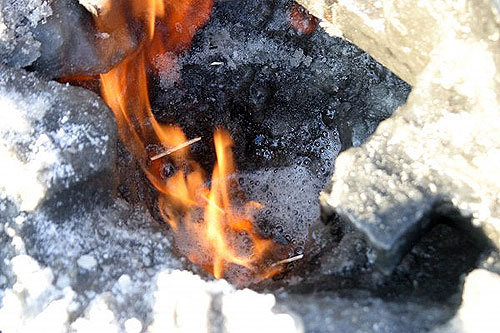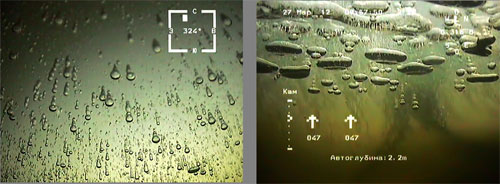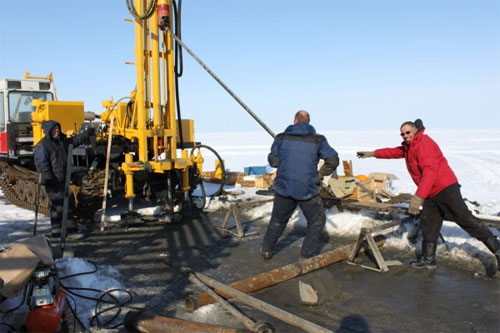
Study: Arctic seafloor methane releases double previous estimatesBy Marmian Grimes November 27, 2013
The East Siberian Arctic Shelf is venting at least 17 teragrams of the methane into the atmosphere each year. A teragram is equal to 1 million tons.
Methane burns as it escapes through a hole in the ice in a lagoon above the East Siberian Arctic Shelf.
Methane is a greenhouse gas more than 30 times more potent than carbon dioxide. On land, methane is released when previously frozen organic material decomposes. In the seabed, methane can be stored as a pre-formed gas or asmethane hydrates. As long as the subsea permafrost remains frozen, it forms a cap, effectively trapping the methane beneath. However, as the permafrost thaws, it develops holes, which allow the methane to escape. These releases can be larger and more abrupt than those that result from decomposition. The findings are the latest in an ongoing international research project led by Shakhova and Igor Semiletov, both researchers at the UAF International Arctic Research Center. Their twice-yearly arctic expeditions have revealed that the subsea permafrost in the area has thawed much more extensively than previously thought, in part due to warming water near the bottom of the ocean. The warming has created conditions that allow the subsea methane to escape in much greater amounts than their earlier models estimated. Frequent storms in the area hasten its release into the atmosphere, much in the same way stirring a soda releases the carbonation more quickly.
Methane bubbles collect under the ice.
The East Siberian Arctic Shelf is a methane-rich area that encompasses more than 2 million square kilometers of seafloor in the Arctic Ocean. It is more than three times as large as the nearby Siberian wetlands, which have been considered the primary Northern Hemisphere source of atmospheric methane. Previous estimates performed for the ESAS suggested that the area was releasing 8 teragrams of methane into the atmosphere yearly. During field expeditions, the research team used a variety of techniques—including sonar and visual images of methane bubbles in the water, air and water sampling, seafloor drilling and temperature readings—to determine the conditions of the water and permafrost, as well as the amount of methane being released.
Members of the scientific field expedition drill through the ice and into the seafloor of the East Siberian Arctic Shelf.
“We believe that the release of methane from the Arctic, and in particular this part of the Arctic, could impact the entire globe,” Shakhova said. “We are trying to understand the actual contribution of the ESAS to the global methane budget and how that will change over time.” Shakhova and Semiletov are also affiliated with the Pacific Oceanological Institute at the Russian Academy of Sciences, Far Eastern Branch, as are research team members Anatoly Salyuk, Denis Kosmach and Denis Chernykh. Other members of the research team include Dmitry Nicolsky of the UAF Geophysical Institute; co-lead author Ira Leifer of the Marine Sciences Institute at the University of California, Santa Barbara and Bubbleology Research International; Valentin Sergienko of the Institute of Chemistry at the Russian Academy of Sciences, Far Eastern Branch; Chris Stubbs of the Marine Sciences Institute at the University of California, Santa Barbara; Vladimir Tumskoy of Moscow State University; and Örjan Gustafsson of the Department of Applied Environmental Science and Bolin Centre for Climate Research, Stockholm University.
Source of News:
E-mail your news &
photos to editor@sitnews.us
|
||


